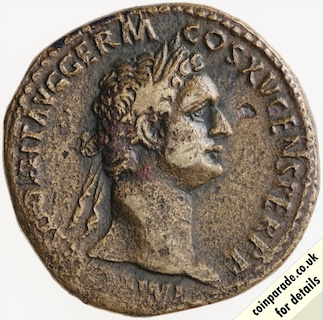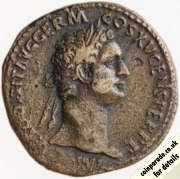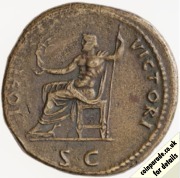
 The 90AD-91AD Sestertius - Domitian
The 90AD-91AD Sestertius - Domitian This is possibly an Orichalcum Sestertius of Emperor Domitian. Orichalcum is a golden-coloured bronze alloy that was often used in ancient Rome. Struck around 90-91AD. Diameter 34mm and weighs 29.59g.
Is it real? The coin was found in a safe in the national Gallery of Victoria (Australia) back in 1904 and some consider it may be a nineteenth century cast copy. It is interesting to note that even museum experts are not entirely sure and highlights the difficulty in evaluating authenticity in coins of this age.
The Obverse shows the laureated head of Emperor Domitian facing right. Legend if "IMP [CAES] DOMIT AVG GERM COS XV CENS PER P P".
 The Reverse shows the God Jupiter seated, holding Victory and a sceptre. Legend is "IOVI VICTORI". "S C" is in exergue. SC means senatus consultum, or 'by decree of the Senate' so the coin was an official issue.
The Reverse shows the God Jupiter seated, holding Victory and a sceptre. Legend is "IOVI VICTORI". "S C" is in exergue. SC means senatus consultum, or 'by decree of the Senate' so the coin was an official issue.Image credit: Museums Victoria
Mintage: Not known
Minted at Roman Mint
More information (monarch, year, mint, country, category) can be found below coin listings.
Below are some coins currently being offered on eBay. As an eBay Partner, We may be compensated if you make a purchase.
List items on:
List items on:
Domitian (Emperor 81AD-96AD)
Classification: Roman Emperor, Roman, Flavian dynastyEmperor Domitian [TITVS FLAVIVS CAESAR DOMITIANVS AVGVSTVS] ruled from 81 to 96. He was born on 24 October 51 and was assassinated by court officials due to his authoritarian behaviour on 18 September 96.
Regnal name: Imperator Caesar Domitianus Augustus
Category: Roman
The Roman Empire was one of the largest Empires in history, covering most of Europe, Britain, parts of Asia, the Middle East and North Africa. It was in existence from 27BC to 476AD, more than 500 years. And all these places used Roman coins throughout the era.Originally coins were minted only in Rome, but by the third Century there were mints in other countries too. These mints sometimes produced more than 2 million coins per month to meet demand. Coins typically depicted the Emperor on one side and some other image or letters on the other. During the Empire, more than 10,000 different types of coins were created using copper, silver and gold.
Roman coins are usually classified as:
- Roman Republican Coins (about 300BC - 27BC)
- Roman Imperial Coins (27BC - 96AD)
- Roman Imperial Coins (96AD - 235AD)
- Roman Imperial Coins (235AD - 476AD)
- Roman Provincial Coins
The Denarius was the standard Roman silver coin and there were a range of others. As a guide, in the early republic (after 211BC) there was the Sestertius (=4 denarii), Dupondius (=5), As (=10, a tenner), Semis (=20), Quincunx (=24), Triens (=30), Quadrans (=40), Uncia (=120) and Solidus (=1000, it was gold). Values fluctuated later due to debasement and inflation.
The exchange values were as follows:
1 gold aureus = 25 silver denarii
1 silver denarius = 16 copper asses
1 brass sestertius = 4 copper asses
1 brass dupondius = 2 copper assses
1 copper as = 2 copper semisses (or 4 copper quadrantes)
The standard gold coin was the Aureus and was equal to 25 denarii or 100 sestertii. It's not far off the weight of a modern gold sovereign. The Aureus was introduced by Julius Caesar around 49BC and was the principal gold coin until about the 4th century when it was replaced by the gold Solidus.
The great part of this is that you can put together a really nice Roman coin collection with very little money, as many coins (although not all) are common and inexpensive. The coins are the best part of 2000 years old and are exciting to collect.
For more information see our articles:
Which Mint: Roman Mint
The origins of the Rome mint are from the manufacture of a silver coin near to the Temple of Juno Moneta back in 269BC. Juno was the personification of money.Due to the size of the Roman Empire, Rome could not produce all the coins needed and Roman mints were set up in 27 locations, and there were more than 600 provincial mints scattered about the Empire. During overseas campaigns, Generals such as Caesar and Marc Anthony would mint their own coins to pay their armies.
Mint marks were used on the coins to differentiate the mint of manufacture.
Country of Origin: Roman Empire
The Roman Empire ran from 27BC to 476AD and was the post-Republican period of ancient Rome. It covered a large territory of Europe, Northern Africa, and Western Asia. It was ruled by an Emperor.







